
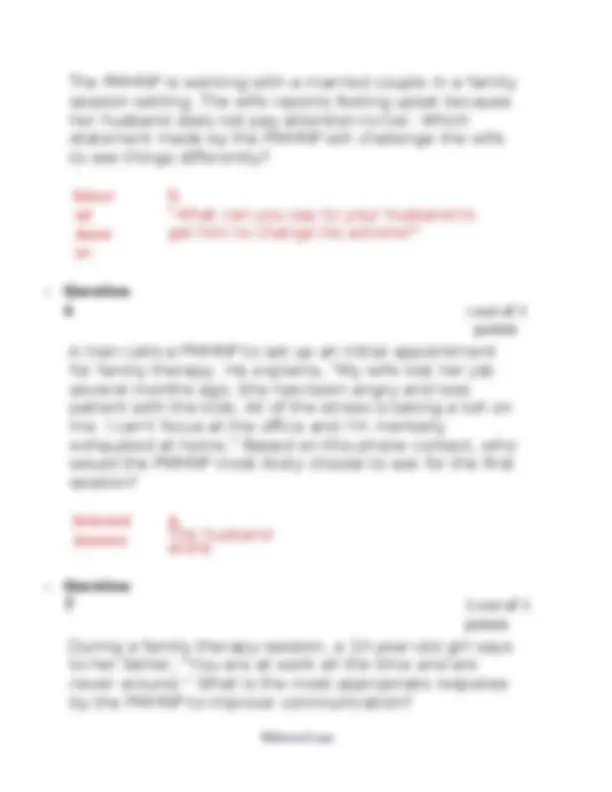
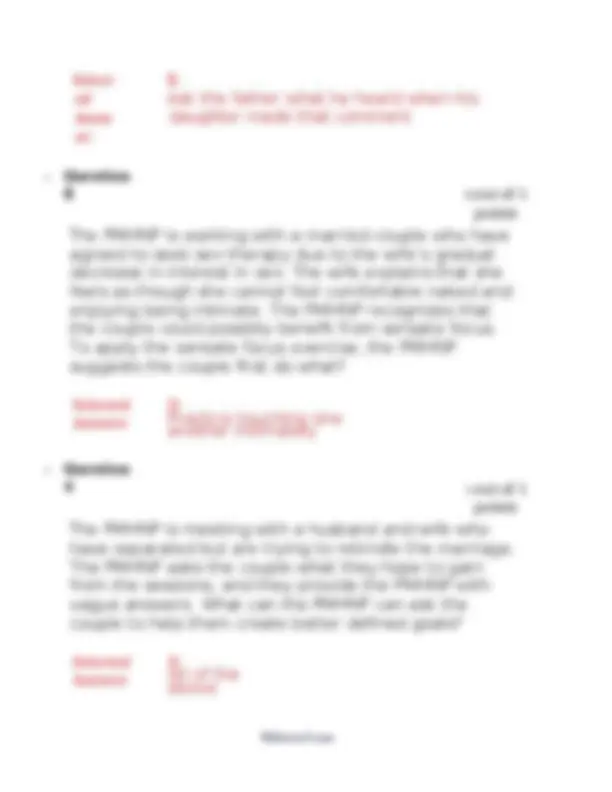
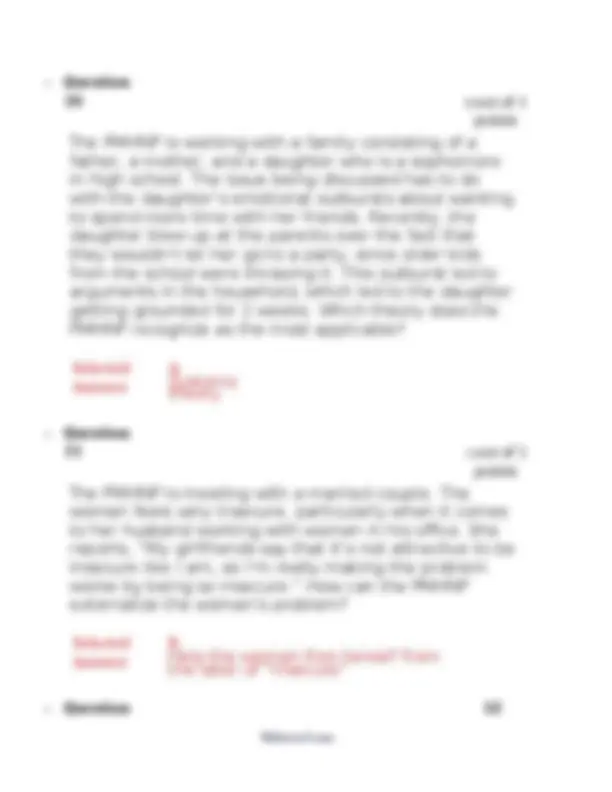

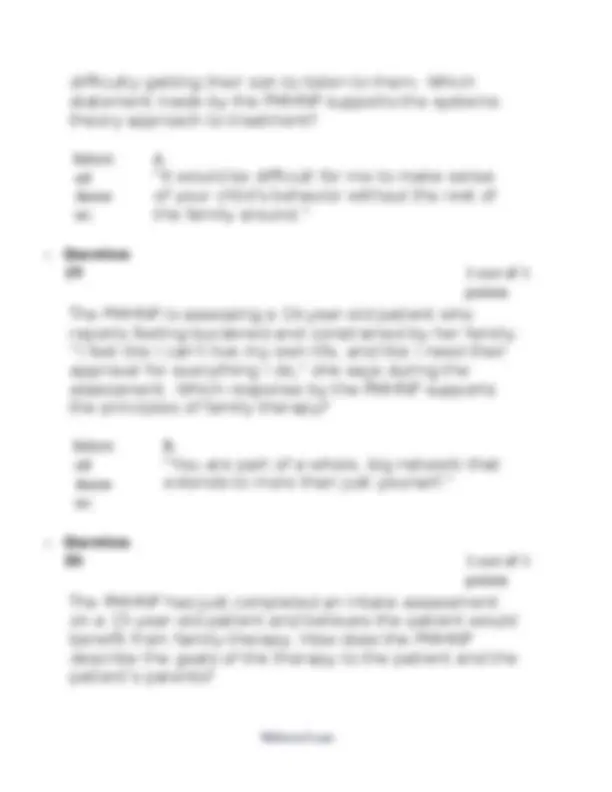
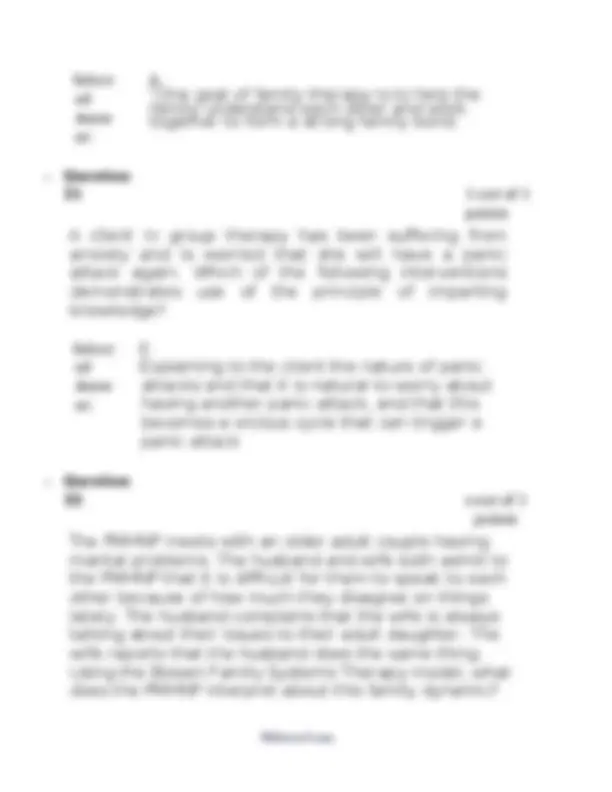
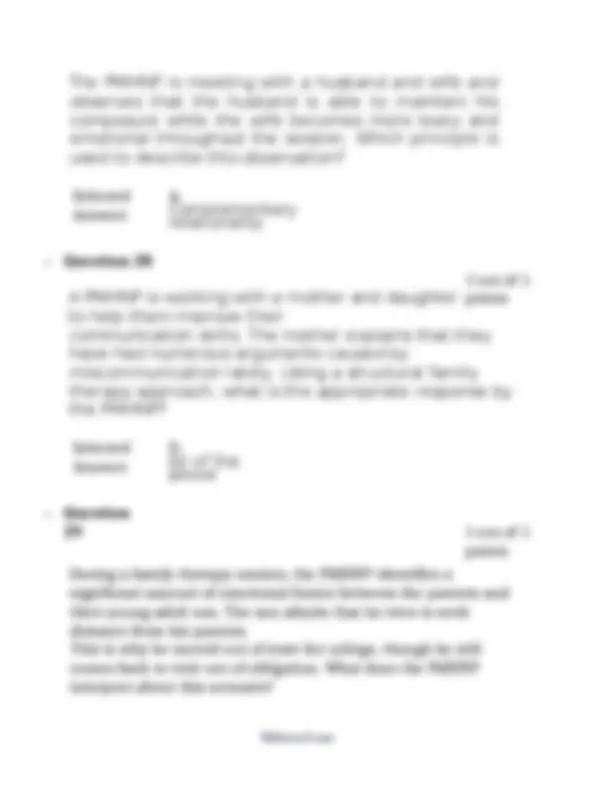
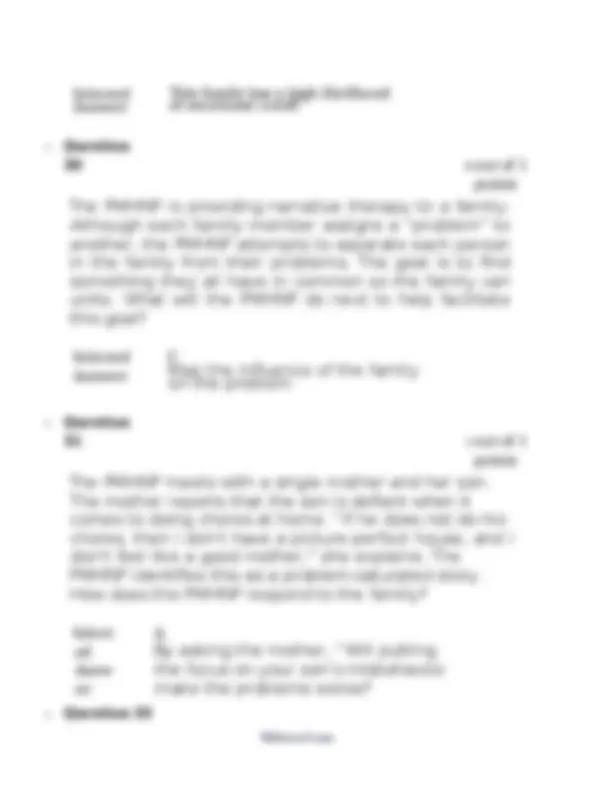
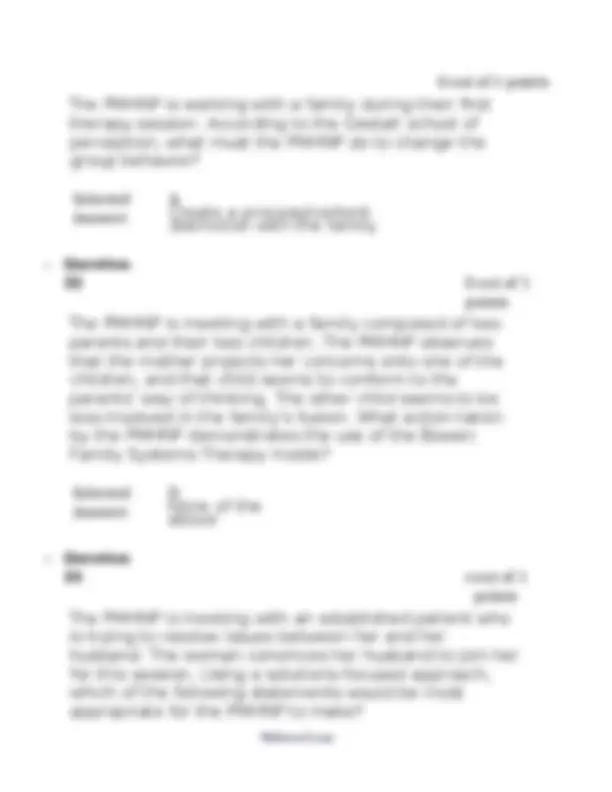
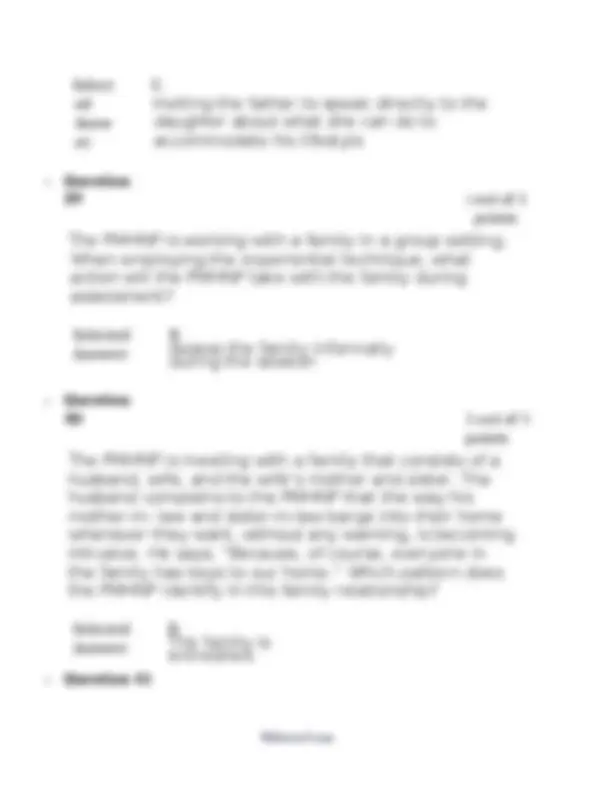
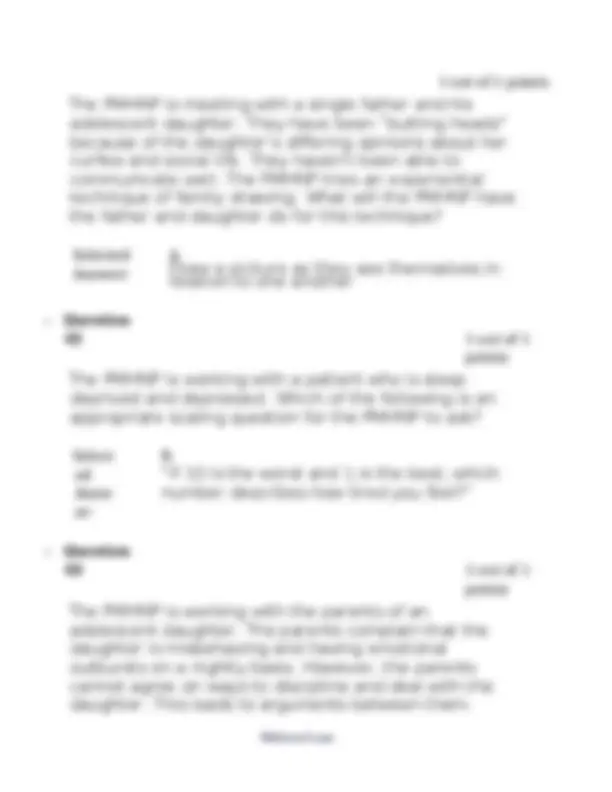
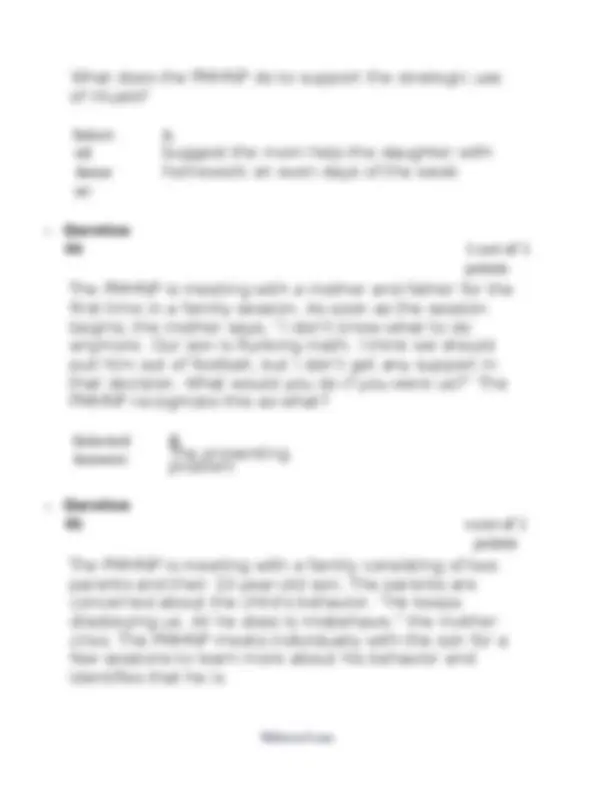
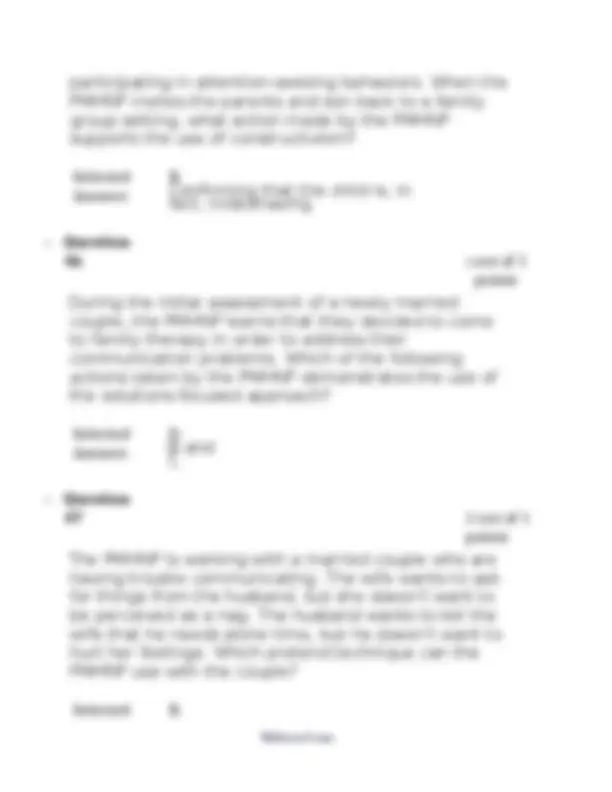
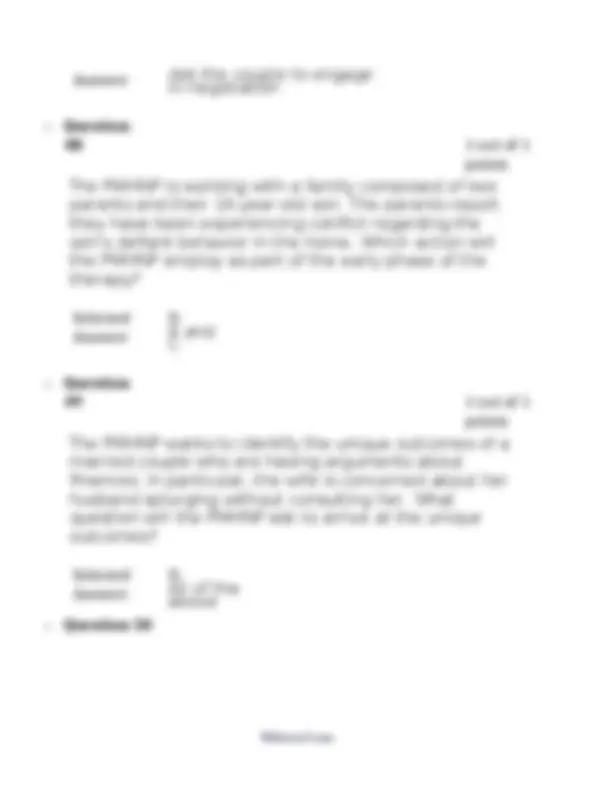
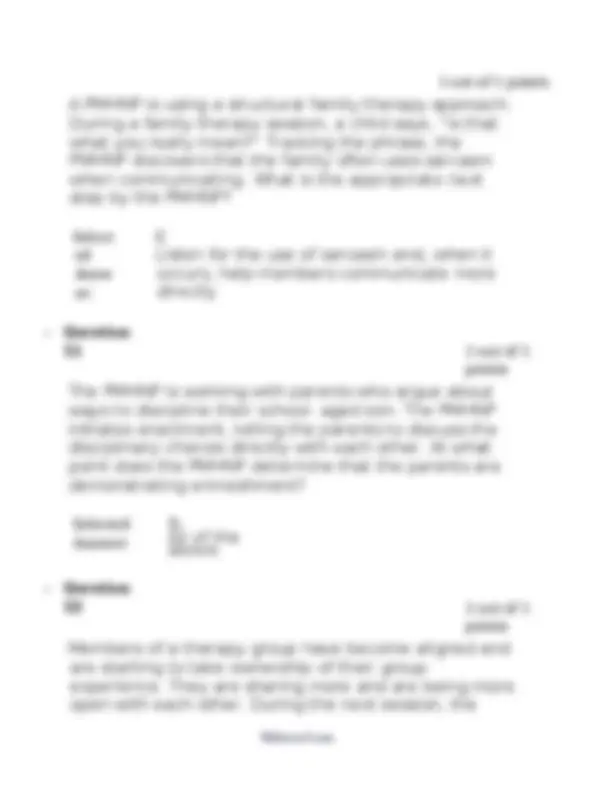
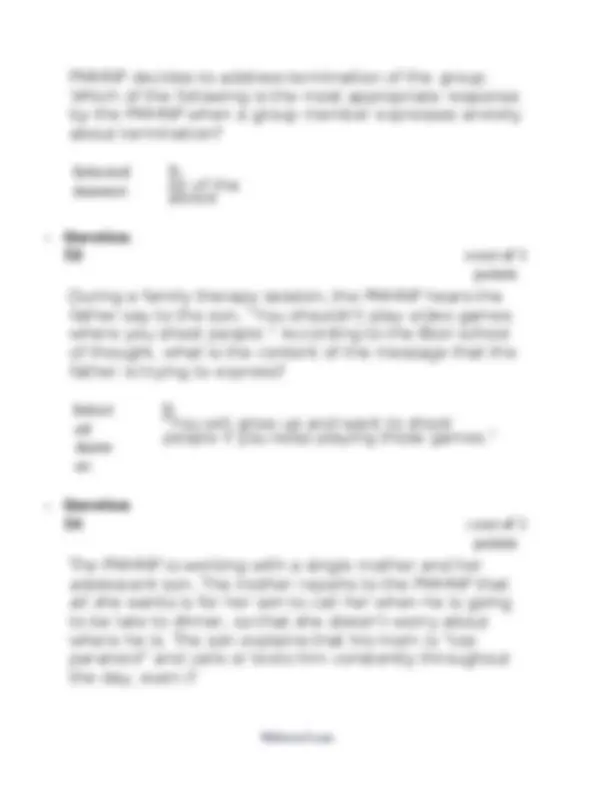
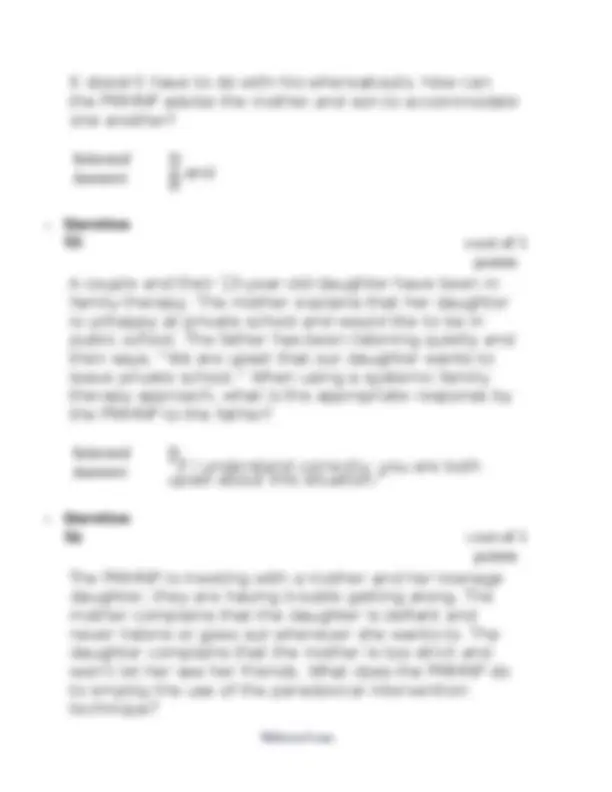
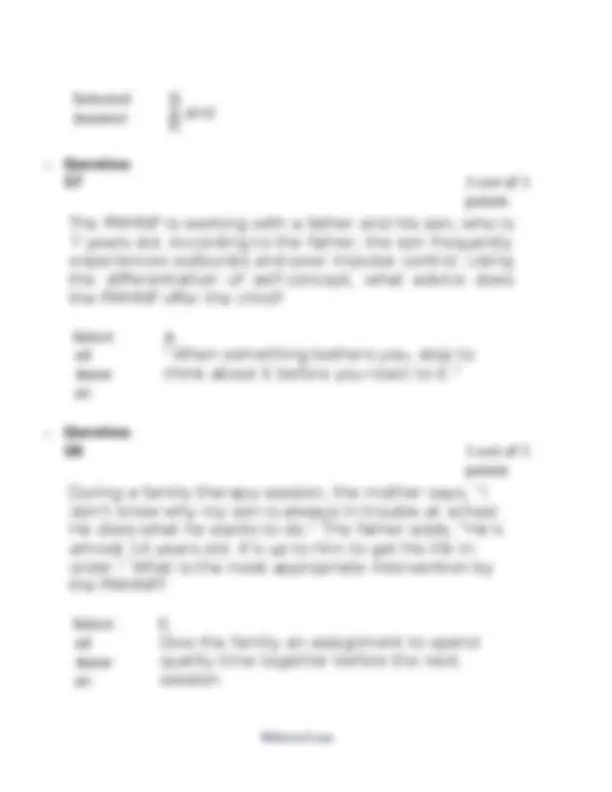
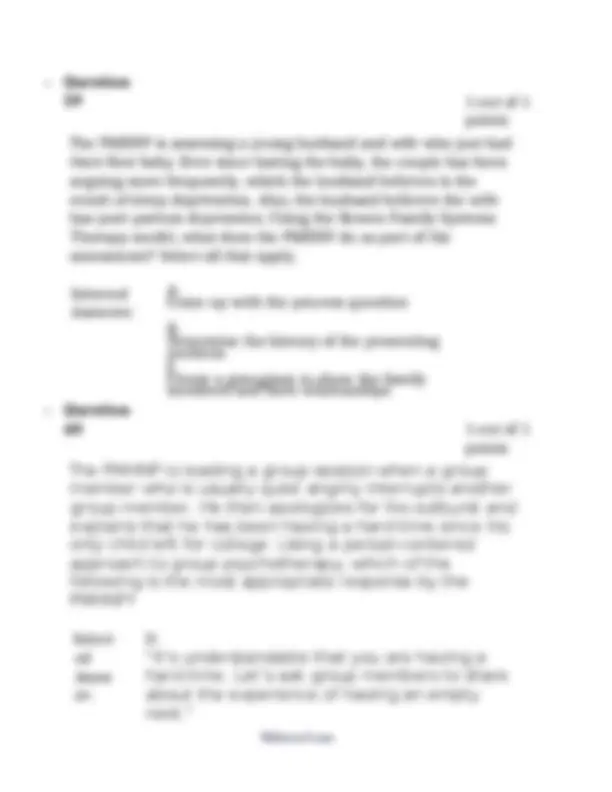
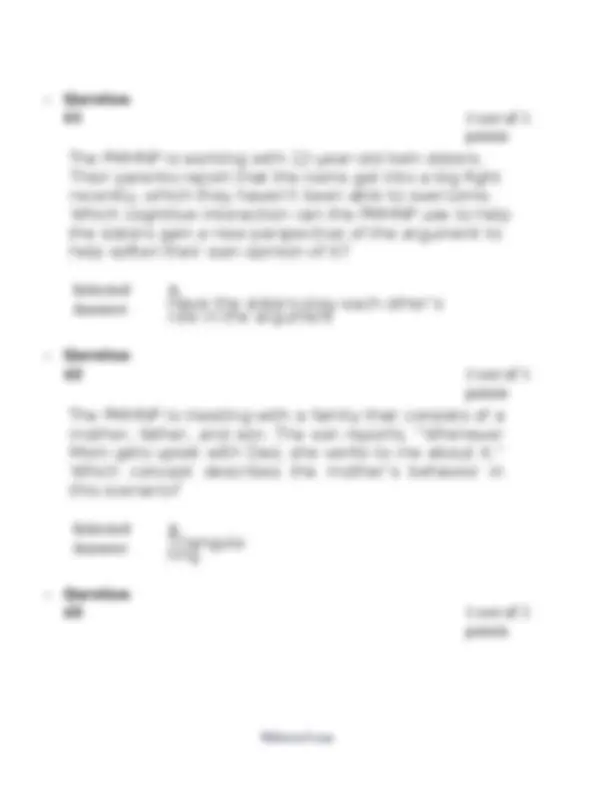
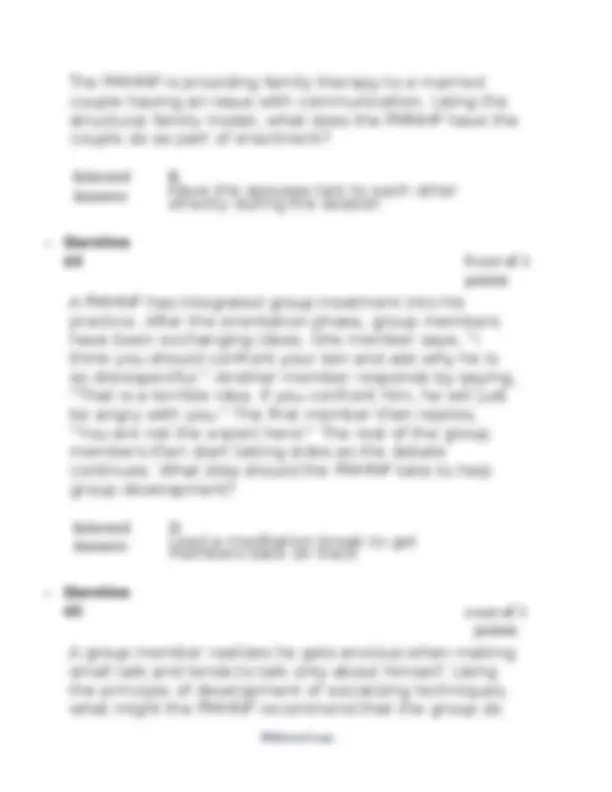
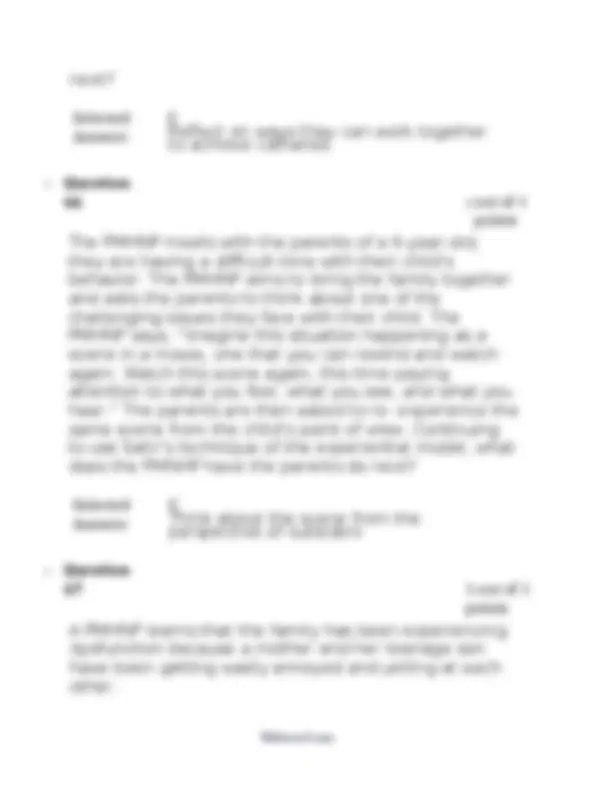
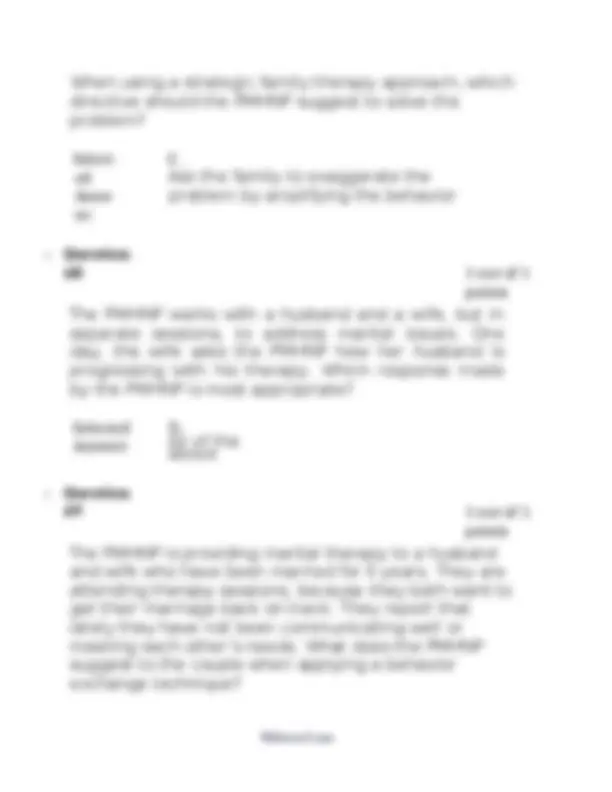
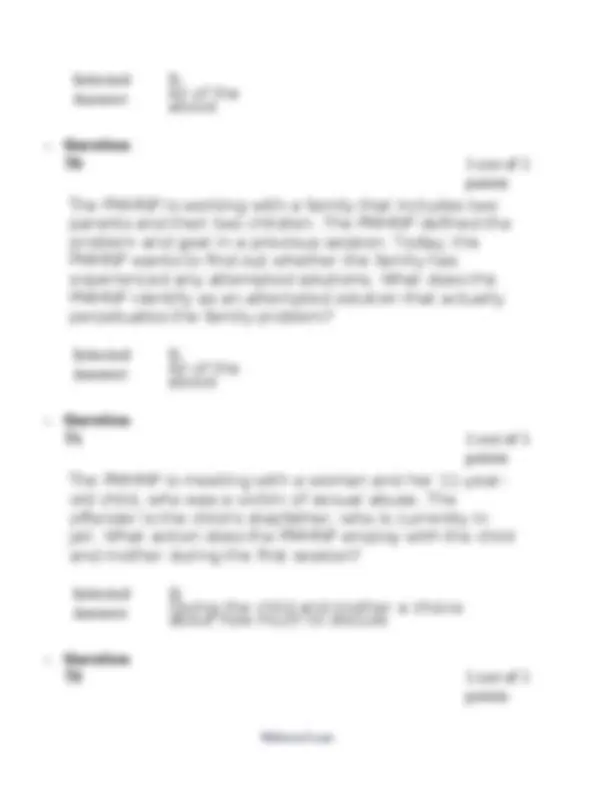
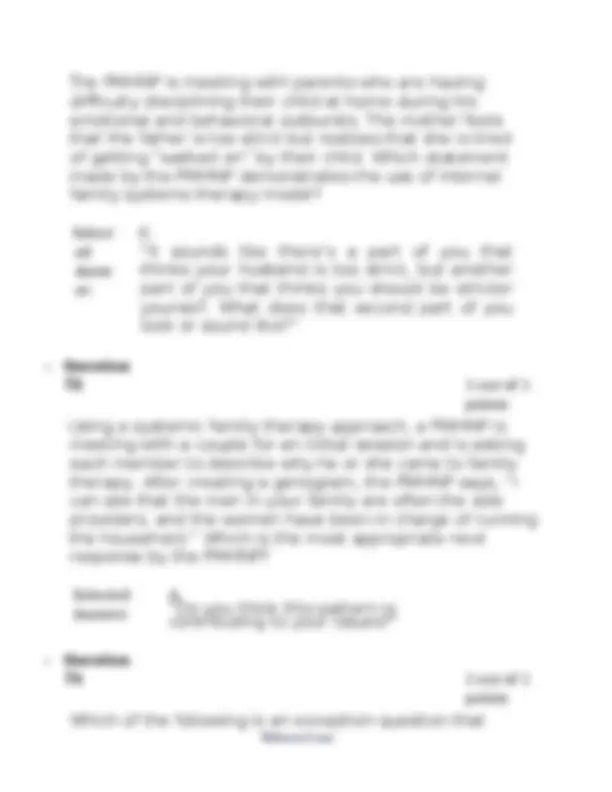



Study with the several resources on Docsity

Earn points by helping other students or get them with a premium plan


Prepare for your exams
Study with the several resources on Docsity

Earn points to download
Earn points by helping other students or get them with a premium plan
Community
Ask the community for help and clear up your study doubts
Discover the best universities in your country according to Docsity users
Free resources
Download our free guides on studying techniques, anxiety management strategies, and thesis advice from Docsity tutors
NURS 6650 Midterm ExamNURS 6650 Midterm Exam
Typology: Exercises
1 / 34

This page cannot be seen from the preview
Don't miss anything!



























Question 1 1 out of 1 points While in a family therapy session, a wife comments, “Instead of spending time with me, he is usually watching sports on television.” Using an emotionally focused family therapy approach, what is an appropriate response by a PMHNP using an evocative question technique? Selected Answer:
“How are you feeling now as you are sharing that?” Question 2 0 out of 1 points The PMHNP is discussing problem-solving techniques with a married couple. What recommendation will the PMHNP provide to the couple? Select ed Answ er:
“Speak calmly, and explain your entire point before asking your partner to respond.” Question (^3) 1 out of 1 points The PMHNP is providing family therapy to two parents
and their twin 14-year-old children. The children become defiant around bedtime and are still working on their homework late into the night. How does the PMHNP employ an experiential technique of family sculpting? Select ed Answ er:
Asks one of the parents to arrange the family into a typical bedtime scene Question 4 1 out of 1 points The PMHNP is assessing a married couple who disclosed on the intake form that that they are having intimacy issues. During the assessment, the PMHNP asks the couple what brings them in today. The wife is quick to answer, “My husband doesn’t listen to me anymore.” Using the Mental Research Institute (MRI) assessment technique, how does the PMHNP respond to this? Selected Answer:
By asking the wife to explain what exactly “not listening” means Question (^5) 0 out of 1 points
Select ed Answ er:
Ask the father what he heard when his daughter made that comment Question 8 0 out of 1 points The PMHNP is working with a married couple who have agreed to seek sex therapy due to the wife’s gradual decrease in interest in sex. The wife explains that she feels as though she cannot feel comfortable naked and enjoying being intimate. The PMHNP recognizes that the couple could possibly benefit from sensate focus. To apply the sensate focus exercise, the PMHNP suggests the couple first do what? Selected Answer:
Practice touching one another intimately Question (^9) 1 out of 1 points The PMHNP is meeting with a husband and wife who have separated but are trying to rekindle the marriage. The PMHNP asks the couple what they hope to gain from the sessions, and they provide the PMHNP with vague answers. What can the PMHNP can ask the couple to help them create better defined goals? Selected Answer:
All of the above
Question (^10) 0 out of 1 points The PMHNP is working with a family consisting of a father, a mother, and a daughter who is a sophomore in high school. The issue being discussed has to do with the daughter’s emotional outbursts about wanting to spend more time with her friends. Recently, the daughter blew up at the parents over the fact that they wouldn’t let her go to a party, since older kids from the school were throwing it. This outburst led to arguments in the household, which led to the daughter getting grounded for 2 weeks. Which theory does the PMHNP recognize as the most applicable? Selected Answer:
Systems theory Question (^11) 1 out of 1 points The PMHNP is meeting with a married couple. The woman feels very insecure, particularly when it comes to her husband working with women in his office. She reports, “My girlfriends say that it’s not attractive to be insecure like I am, so I’m really making the problem worse by being so insecure.” How can the PMHNP externalize the woman’s problem? Selected Answer:
Help the woman free herself from the label of “insecure” Question 12
Question (^14) 1 out of 1 points The PMHNP is meeting with two women, ages 35 and 42, who are concerned about their mother’s use of alcohol. During the meeting, what question(s) should the PMHNP ask the mother to help uncover the potential drinking problem? Selected Answer:
B and C Question (^15) 1 out of 1 points The PMHNP is meeting with a mother and her 9-year- old child. The child is upset that the father left the house and hasn’t been back in a long time. Which action will the PMHNP perform to employ the role- playing technique with the child? Select ed Answ er:
Set up an empty space on the couch and have the child talk to the father as if he were sitting there Question 16 1 out of 1 points The PMHNP is meeting with a family that consists of a mother and father and their two daughters, ages 8 and
smart one.” Which family therapy theory is most applicable to this family? Selected Answer:
Role theory Question 17 1 out of 1 points The PMHNP is meeting with a married couple who have recently had a baby. The transition of becoming new parents has caused a lot of friction and tension in the household. The wife wishes the husband would help out at least once with the nighttime feedings so she can get more than 3 hours of sleep at night. The husband feels like this is an unfair request, because the wife no longer works, but she still asks the husband to do a lot of errands during the day. What does the PMHNP do to create a quid pro quo contract between the husband and wife? Select ed Answ er:
Suggest the wife to agree to do more errands during the day, and then have the husband agree to do one nighttime feeding Question 18 1 out of 1 points The PMHNP meets with the parents of a 3-year-old boy, who was adopted at 6 months of age. The parents ask the PMHNP if he will see the child individually for therapy sessions on a weekly basis, based on the fact that the parents are having
Select ed Answ er:
“One goal of family therapy is to help the family understand each other and work together to form a strong family bond. Question 21 1 out of 1 points A client in group therapy has been suffering from anxiety and is worried that she will have a panic attack again. Which of the following interventions demonstrates use of the principle of imparting knowledge? Select ed Answ er:
Explaining to the client the nature of panic attacks and that it is natural to worry about having another panic attack, and that this becomes a vicious cycle that can trigger a panic attack Question 22 0 out of 1 points The PMHNP meets with an older adult couple having marital problems. The husband and wife both admit to the PMHNP that it is difficult for them to speak to each other because of how much they disagree on things lately. The husband complains that the wife is always talking about their issues to their adult daughter. The wife reports that the husband does the same thing. Using the Bowen Family Systems Therapy model, what does the PMHNP interpret about this family dynamic?
Select ed Answ er:
There is an emotional cutoff between the parents and their adult daughter. Question (^23) 1 out of 1 points The PMHNP is working with the parents of an 8-year- old. They are facing challenges with their daughter’s school because of her behavior toward other students. “Our daughter has become a problem,” they explain. Which statement(s) made by the PMHNP supports the use of the narrative therapy model? Selected Answer:
A and B Question 24 1 out of 1 points The PMHNP is meeting with a single mother and her 19-year-old son who lives with her. The son complains that his mother is always nagging him. What is the PMHNP’s interpretation of this scenario according to a complementarity approach? Select ed Answ er:
It is possible that the mother feels as though she is not being heard by her son.
The PMHNP is meeting with a husband and wife and observes that the husband is able to maintain his composure while the wife becomes more teary and emotional throughout the session. Which principle is used to describe this observation? Selected Answer:
Complementary relationship Question 28 A PMHNP is working with a mother and daughter to help them improve their 1 out of 1 points communication skills. The mother explains that they have had numerous arguments caused by miscommunication lately. Using a structural family therapy approach, what is the appropriate response by the PMHNP? Selected Answer:
All of the above Question 29 1 out of 1 points During a family therapy session, the PMHNP identifies a significant amount of emotional fusion between the parents and their young adult son. The son admits that he tries to seek distance from his parents. This is why he moved out of state for college, though he still comes back to visit out of obligation. What does the PMHNP interpret about this scenario?
Selected Answer: This family has a high likelihood of emotional cutoff. Question 30 0 out of 1 points The PMHNP is providing narrative therapy to a family. Although each family member assigns a “problem” to another, the PMHNP attempts to separate each person in the family from their problems. The goal is to find something they all have in common so the family can unite. What will the PMHNP do next to help facilitate this goal? Selected Answer:
Map the influence of the family on the problem Question 31 1 out of 1 points The PMHNP meets with a single mother and her son. The mother reports that the son is defiant when it comes to doing chores at home. “If he does not do his chores, then I don’t have a picture-perfect house, and I don’t feel like a good mother,” she explains. The PMHNP identifies this as a problem-saturated story. How does the PMHNP respond to the family? Select ed Answ er:
By asking the mother, “Will putting the focus on your son’s misbehavior make the problems worse? Question 32
Selected Answer:
“Are you interested in attending sessions regularly?” Question 35 1 out of 1 points The PMHNP is meeting with a mother and her adult daughter, who report that they have had a hard time getting long. The adult daughter complains that her mother tells her what to do regarding her children, which puts strain on the adult daughter’s marriage. The mother denies this and explains that she is “only trying to help.” What does the PMHNP say to the mother or daughter to convey acceptance into this family? Selected Answer:
A and B Question (^36) 1 out of 1 points A family is in therapy because they have been unable to resolve conflicts and are arguing frequently. When using a strategic family therapy approach, which of the following directives might the PMHNP suggest to create a sense of togetherness?
Select ed Answ er:
Exaggerate in a fun family ritual by preparing for the event in a specific order Question (^37) 1 out of 1 points The PMHNP is assessing a family that consists of a mother and a father and their daughter Rachel. The family is discussing the issue of time management in the home, particularly involving the daughter’s extracurricular schedule. The mother asks, “Rachel, how many times has your father been late to pick you up from soccer?” What does the PMHNP take away from this interaction? Selected Answer:
The family is involved in pairing. Question 38 0 out of 1 points The PMHNP is working with a father and his teenage daughter. The father has full custody of his daughter as of recently. He reports that the two of them get into arguments all the time over curfew, chores, and the daughter’s lack of responsibility that “she gets from her mother.” The daughter feels like the father never listens to her. Which of the following actions taken by the PMHNP demonstrates unbalancing the relationship?
1 out of 1 points The PMHNP is meeting with a single father and his adolescent daughter. They have been “butting heads” because of the daughter’s differing opinions about her curfew and social life. They haven’t been able to communicate well. The PMHNP tries an experiential technique of family drawing. What will the PMHNP have the father and daughter do for this technique? Selected Answer:
Draw a picture as they see themselves in relation to one another Question 42 1 out of 1 points The PMHNP is working with a patient who is sleep deprived and depressed. Which of the following is an appropriate scaling question for the PMHNP to ask? Select ed Answ er:
“If 10 is the worst and 1 is the best, which number describes how tired you feel?” Question 43 1 out of 1 points The PMHNP is working with the parents of an adolescent daughter. The parents complain that the daughter is misbehaving and having emotional outbursts on a nightly basis. However, the parents cannot agree on ways to discipline and deal with the daughter. This leads to arguments between them.
What does the PMHNP do to support the strategic use of rituals? Select ed Answ er:
Suggest the mom help the daughter with homework on even days of the week Question 44 1 out of 1 points The PMHNP is meeting with a mother and father for the first time in a family session. As soon as the session begins, the mother says, “I don’t know what to do anymore. Our son is flunking math. I think we should pull him out of football, but I don’t get any support in that decision. What would you do if you were us?” The PMHNP recognizes this as what? Selected Answer:
The presenting problem Question 45 0 out of 1 points The PMHNP is meeting with a family consisting of two parents and their 10-year-old son. The parents are concerned about the child’s behavior. “He keeps disobeying us. All he does is misbehave,” the mother cries. The PMHNP meets individually with the son for a few sessions to learn more about his behavior and identifies that he is